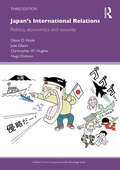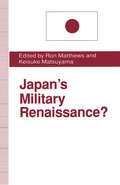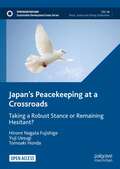- Table View
- List View
Japan's International Democracy Assistance as Soft Power: Neoclassical Realist Analysis (Politics in Asia)
by Maiko IchiharaJapan has increasingly emphasized democracy assistance since the mid-2000s, such that it now constitutes a major part of Japan’s foreign policy. This approach is an ostensible departure from the country’s traditional foreign policy stance, which tries to avoid bringing values to the forefront of foreign policies. This book intends to answer the questions of why Japan has started emphasizing democracy assistance and why it has relegated itself to a minor role in democracy assistance nevertheless. It argues that Japan’s emphasis on democracy assistance reveals its intention to increase its political influence with regards to China based on democratic values, and its usage of the term "democracy assistance" is a performative speech act to orchestrate a comprehensive approach for international democracy support. Shedding light on the novel aspect of Japanese policy, this book contributes to the understanding of Japanese foreign policy and democracy promotion. Providing the analysis that state’s speech act could cause to create foreign policies that counter what is predicted by structural realism, this analysis makes contributions to neoclassical realism which explains states’ foreign policy choices within the constraints of international structure.
Japan's International Relations: Politics, Economics and Security (The University of Sheffield/Routledge Japanese Studies Series)
by Glenn D. Hook Julie Gilson Christopher W. Hughes Hugo DobsonThe latest edition of this comprehensive and user-friendly textbook provides a single volume resource for all those studying Japan's international relations. It offers a clear and concise introduction to the most important aspects of Japan's role in the globalized economy of the twenty-first century. The book has been fully updated and revised to include comprehensive discussions of contemporary key issues for Japan’s IR, including: the rise of China; reaction to the global economic and financial crisis since 2008; Japan’s proactive role after 9/11 and the war on terror; responses to events on the Korean Peninsula; relations with the USA and the Obama administration; relations with Russia, Central Asia and the Middle East; changing responses to an expanding and deepening European Union. Extensively illustrated, the text includes statistics, maps, photographs, summaries and suggestions for further reading, making it essential reading for those studying Japanese politics and the international relations of the Asia Pacific. A note on the cover: The cover illustration entitled 'Double Standard' is a Japanese manga penned by satirical artist Ichihanahana in November 2010 regarding rising Japanese nationalism, Japan-China tensions over the disputed territory of the Senkaku islands and the US presence in Okinawa. This manga demonstrates many of the key themes in Japan’s ties with China and the US, but also a number of other central features of Japan’s international relations as explored throughout this text.
Japan's International Relations: Politics, Economics and Security (The University of Sheffield/Routledge Japanese Studies Series)
by Christopher W. Hughes Glenn D. Hook Julie Gilson Hugo DobsonThe latest edition of this comprehensive and user-friendly textbook provides a single volume resource for all those studying Japan's international relations. It offers a clear and concise introduction to the most important aspects of Japan's role in the globalized economy of the twenty-first century. The book has been fully updated and revised to include comprehensive discussions of contemporary key issues for Japan’s IR, including: the rise of China; reaction to the global economic and financial crisis since 2008; Japan’s proactive role after 9/11 and the war on terror; responses to events on the Korean Peninsula; relations with the USA and the Obama administration; relations with Russia, Central Asia and the Middle East; changing responses to an expanding and deepening European Union. Extensively illustrated, the text includes statistics, maps, photographs, summaries and suggestions for further reading, making it essential reading for those studying Japanese politics and the international relations of the Asia Pacific. A note on the cover: The cover illustration entitled 'Double Standard' is a Japanese manga penned by satirical artist Ichihanahana in November 2010 regarding rising Japanese nationalism, Japan-China tensions over the disputed territory of the Senkaku islands and the US presence in Okinawa. This manga demonstrates many of the key themes in Japan’s ties with China and the US, but also a number of other central features of Japan’s international relations as explored throughout this text.
Japan's International Relations (Bloomsbury Academic Collections: Japan)
by Takashi InoguchiJapan's International Relations focuses on three major issues: firstly, Japan's role in relation to its place in the international structure, its economic dynamism and its historical past. Secondly, how Japan's role is manifested in a number of key areas; economic, security, bilateral and regional. Thirdly, Inoguchi analyses the Japan's role in the light of the continuing US-Soviet détente, an enlarged Europe, continuing Pacific dynamism and global economic difficulties.First published in 1991, this title is part of the Bloomsbury Academic Collections series.
Japan’s Island Troubles with China and Korea: Prospects and Challenges for Resolution (Politics in Asia)
by Victor Teo Haruko SatohThis book examines the Senkaku/Diaoyu dispute between Japan and China and the Dokdo/Takeshima dispute between Japan and Korea, in order to offer new perspectives on the possible approaches towards amelioration and resolution of these conflicts. Japan’s Island Troubles with China and Korea addresses the prospects of and challenges to achieving resolutions in the island disputes, rather than focusing solely on the origins and the political roles they play in the domestic politics of the three nations. Furthermore, in taking an interdisciplinary approach, this book transcends existing studies, which focus on the domestic contexts of the disputes, and therefore avoids the pitfalls of nationalistic narratives. Instead, this book fills a theoretical and methodological lacuna in the academic literature, exploring how the islands could become a point of co-operation, rather than contention. Providing a fresh examination of Japan’s relations with its two closest neighbours, this book will be invaluable to students and scholars of Asian politics and international relations, security studies, and Asia-Pacific studies more generally.
Japan’s Island Troubles with China and Korea: Prospects and Challenges for Resolution (Politics in Asia)
by Victor Teo Haruko SatohThis book examines the Senkaku/Diaoyu dispute between Japan and China and the Dokdo/Takeshima dispute between Japan and Korea, in order to offer new perspectives on the possible approaches towards amelioration and resolution of these conflicts. Japan’s Island Troubles with China and Korea addresses the prospects of and challenges to achieving resolutions in the island disputes, rather than focusing solely on the origins and the political roles they play in the domestic politics of the three nations. Furthermore, in taking an interdisciplinary approach, this book transcends existing studies, which focus on the domestic contexts of the disputes, and therefore avoids the pitfalls of nationalistic narratives. Instead, this book fills a theoretical and methodological lacuna in the academic literature, exploring how the islands could become a point of co-operation, rather than contention. Providing a fresh examination of Japan’s relations with its two closest neighbours, this book will be invaluable to students and scholars of Asian politics and international relations, security studies, and Asia-Pacific studies more generally.
Japan’s Long Stagnation, Deflation, and Abenomics: Mechanisms and Lessons
by Kenji AramakiThis book examines the struggles of the Japanese economy over the last 30 years, analyzing in detail the formation of the huge economic bubble in the 1980s, its collapse at the beginning of the 1990s, and subsequent two decade long economic stagnation and chronic deflation, with the aim of identifying the mechanism of such processes and drawing lessons for future economic policy management. The book also assesses the comprehensive policy efforts called “Abenomics” under the current Abe administration. As Abe continues into a new term, this book will be of interest to Japan scholars, economists, and policymakers around the world, particularly in Asia.
Japan’s Lost Decade: Lessons for Asian Economies (ADB Institute Series on Development Economics)
by Naoyuki Yoshino Farhad Taghizadeh-HesaryThis book discusses Japan’s long-term economic recession and provides remedies for that recession that are useful for other Asian economies. The book addresses why Japan’s economy has stagnated since the bursting of its economic bubble in the 1990s. Its empirical analysis challenges the beliefs of some economists, such as Paul Krugman, that the Japanese economy is caught in a liquidity trap. This book argues that Japan’s economic stagnation stems from a vertical “investment–saving” (IS) curve rather than a liquidity trap. The impact of fiscal policy has declined drastically, and the Japanese economy faces structural problems rather than a temporary downturn. These structural problems have many causes: an aging demographic (a problem that is frequently overlooked), an over-reliance by local governments on transfers from the central government, and Basel capital requirements that have made Japanese banks reluctant to lend money to start-up businesses and small and medium-sized enterprises. This latter issue has discouraged Japanese innovation and technological progress. All these issues are addressed empirically and theoretically, and several remedies for Japan’s long-lasting recession are provided. This volume will be of interest to researchers and policy makers not only in Japan but also the People’s Republic of China, many countries in the eurozone, and the United States, which may face similar challenges in the future.
Japan's Maritime Security Strategy: The Japan Coast Guard and Maritime Outlaws (Critical Studies of the Asia-Pacific)
by L. BlackSince the late 1990s, the Japan Coast Guard (JCG) has countered a myriad of 'outlaw' threats at sea including piracy, terrorism, the proliferation of Weapons of Mass Destruction (WMD) and the threat posed by 'rogue states'. Japan's innovative strategy has transformed maritime security governance in Southeast Asia and beyond.
Japan’s Military Renaissance?
by Keisuke Matsuyama Ron MatthewsThe purpose of this book is to examine the security-related aspects behind Japan's emerging internationalism. Japan has for some time been projecting a higher international profile, which the Diet's approval to allow Japanese armed forces to operate abroad is but one manifestation. The book's scope is not limited to military issues; it embraces a spectrum of security-related topics such as constitutional amendment, international re-alignment and cooperation, defence industrialisation, Japan-US relations and technology leakage, and Japan's role in the new international order.
Japan’s Nationalist Right in the Internet Age: Online Media and Grassroots Conservative Activism (Routledge Contemporary Japan Series)
by Jeffrey J. HallJapan’s nationalist right have used the internet to organize offline activism in increasingly visible ways. Hall investigates the role of internet-mediated activism in Japan’s ongoing historical and territorial disputes. He explores the emergence of two right-wing activist organizations, Nihon Bunka Channel Sakura and Ganbare Nippon, which have played a significant role in pressure campaigns against Japanese media outlets, campaigns to influence historical memorials, and campaigns to assert Japan’s territorial claim to the Senkaku/Diaoyu Islands. Taking a multi-disciplinary approach, he analyses how activists maintained cohesion, raised funds, held protests that regularly drew hundreds to thousands of participants, and used fishing boats to land activists on disputed islands. Detailing events that took place between 2004 and 2020, he demonstrates how skilled social actors built cohesive grassroots protest organizations through the creation of shared meaning for their organization and its supporters. A valuable read both for scholars seeking insight into the dynamics surrounding Japan’s history disputes and territorial issues, as well as those seeking to compare Japanese right-wing internet activism with its counterparts elsewhere.
Japan’s Nationalist Right in the Internet Age: Online Media and Grassroots Conservative Activism (Routledge Contemporary Japan Series)
by Jeffrey J. HallJapan’s nationalist right have used the internet to organize offline activism in increasingly visible ways. Hall investigates the role of internet-mediated activism in Japan’s ongoing historical and territorial disputes. He explores the emergence of two right-wing activist organizations, Nihon Bunka Channel Sakura and Ganbare Nippon, which have played a significant role in pressure campaigns against Japanese media outlets, campaigns to influence historical memorials, and campaigns to assert Japan’s territorial claim to the Senkaku/Diaoyu Islands. Taking a multi-disciplinary approach, he analyses how activists maintained cohesion, raised funds, held protests that regularly drew hundreds to thousands of participants, and used fishing boats to land activists on disputed islands. Detailing events that took place between 2004 and 2020, he demonstrates how skilled social actors built cohesive grassroots protest organizations through the creation of shared meaning for their organization and its supporters. A valuable read both for scholars seeking insight into the dynamics surrounding Japan’s history disputes and territorial issues, as well as those seeking to compare Japanese right-wing internet activism with its counterparts elsewhere.
Japans neue Immigrationspolitik: Ostasiatisches Umfeld, ideelle Diversität und institutionelle Fragmentierung (Ostasien im 21. Jahrhundert)
by Chiavacci DavidJapan wurde lange als ein Paradebeispiel für ein Nichtimmigrationsland unter den fortgeschrittenen Industrieländern betrachtet. Doch seit Mitte der 1980er Jahre hat sich auch Japan parallel zur Etablierung der ostasiatischen Migrationsregion in ein Immigrationsland transformiert und verzeichnet seither signifikante und kontinuierliche Zu- und Einwanderungsströme. Die vorliegende Studie untersucht Japans neue Immigrationspolitik der beiden letzten Dekaden in ihrem regionalen Kontext in Ostasien. Zwar wird in der Fachliteratur oft angenommen, dass die japanische Immigrationspolitik primär durch einen stark ausgeprägten Ethnonationalismus geformt wird. Eine detaillierte Analyse zeigt jedoch, dass sich die japanische Immigrationspolitik im Gegenteil gerade durch eine ideelle Diversität auszeichnet. Der Politikprozess weist zudem eine institutionelle Fragmentierung auf, was zu einer gegenseitigen Blockierung der Politikakteure vor dem Hintergrund ihrer unterschiedlichen ideellen Perspektiven und den damit verbundenen Politikpräferenzen führt. Die Folge dieser ideellen Diversität und institutionellen Fragmentierung ist eine Diskrepanz zwischen offizieller und realer Immigrationspolitik. Das Fehlen einer langfristigen Strategie und proaktiven Ausrichtung der Immigrationspolitik in Japan in den letzten Jahren ist nicht die Folge einer Schwäche des japanischen Staates gegen außen, sondern einer Immobilisierung aufgrund dieser internen Fragmentierung.
Japan’s New Imperialism
by Rob StevenThe spectacular rise of the yen in the mid-1980s has unleashed a new wave of imperialism from Japan. Its origins are traced to a series of crises and rivalries between the two great capitalist powers, Japan and the USA. To escape the high yen, Japanese capital is closing down factories at home and shifting them overseas. Some are going to the advanced countries, but the book's main focus is on the search for cheap labour in Southeast Asia to make parts for Japan's two leading industries: motor vehicles and electronics.
Japan's new security partnerships: Beyond the security alliance (Manchester University Press)
by Paul Midford Wilhelm VosseAfter decades of solely relying on the United States for its national security needs, over the last decade, Japan has begun to actively develop and deepen its security ties with a growing number of countries and actors in the Asia-Pacific region and Europe, a development that has further intensified under the Shinzo Abe administration. This is the first book that provides a comprehensive analysis of the motives and objectives from both the Japanese and the partner-countries’ perspectives, and asks what this might mean for the security architecture in the Asia-Pacific region, and what lessons can be learned for security cooperation more broadly.This book is for those interested in Japan’s security policy beyond the US-Japan security alliance, and non-US centred bilateral and multilateral security cooperation. It is an ideal textbook for undergraduate and graduate level courses on regional security cooperation and strategic partnerships, and Japanese foreign and security policy.
Japan's new security partnerships: Beyond the security alliance (Manchester University Press)
by WILHELM VOSSE AND PAUL MIDFORDAfter decades of solely relying on the United States for its national security needs, over the last decade, Japan has begun to actively develop and deepen its security ties with a growing number of countries and actors in the Asia-Pacific region and Europe, a development that has further intensified under the Shinzo Abe administration. This is the first book that provides a comprehensive analysis of the motives and objectives from both the Japanese and the partner-countries’ perspectives, and asks what this might mean for the security architecture in the Asia-Pacific region, and what lessons can be learned for security cooperation more broadly.This book is for those interested in Japan’s security policy beyond the US-Japan security alliance, and non-US centred bilateral and multilateral security cooperation. It is an ideal textbook for undergraduate and graduate level courses on regional security cooperation and strategic partnerships, and Japanese foreign and security policy.
Japan's New World Role
by Joshua D. KatzThis book aims to provide a glimpse into the vital debate among Japanese and Western scholars, policymakers, and private sector leaders concerning Japan's future course—a process with implications extending far beyond Japan to the entire world political system.
Japan's New World Role
by Joshua D. Katz Tilly C. Friedman-LichtscheinThis book aims to provide a glimpse into the vital debate among Japanese and Western scholars, policymakers, and private sector leaders concerning Japan's future course—a process with implications extending far beyond Japan to the entire world political system.
Japan's Nuclear Disarmament Policy and the U.S. Security Umbrella
by A. DiFilippoThis book explores the apparent contradictions behind Japan's stated goal of nuclear disarmament and its tacit acceptance of being protected by the U.S. nuclear umbrella.
Japan's Nuclear Disaster and the Politics of Safety Governance
by Florentine KoppenborgIn Japan's Nuclear Disaster and the Politics of Safety Governance, Florentine Koppenborg argues that the regulatory reforms taken up in the wake of the Fukushima disaster on March 11, 2011, directly and indirectly raised the costs of nuclear power in Japan. The Nuclear Regulation Authority resisted capture by the nuclear industry and fundamentally altered the environment for nuclear policy implementation. Independent safety regulation changed state-business relations in the nuclear power domain from regulatory capture to top-down safety regulation, which raised technical safety costs for electric utilities. Furthermore, the safety agency's extended emergency preparedness regulations expanded the allegorical backyard of NIMBY demonstrations. Antinuclear protests, mainly lawsuits challenging restarts, incurred additional social acceptance costs. Increasing costs undermined pronuclear actors' ability to implement nuclear power policy and caused a rift inside the "nuclear village." Small nuclear safety administration reforms were, in fact, game changers for nuclear power politics in Japan. Koppenborg's findings contribute to the vibrant conversations about the rise of independent regulatory agencies, crisis as a mechanism for change, and the role of nuclear power amid global interest in decarbonizing our energy supply.
Japan’s Nuclear Identity and Its Implications for Nuclear Abolition
by Daisuke AkimotoThis book examines Japan’s nuclear identity and its implications for abolition of nuclear weapons. By applying analytical eclecticism in combination with international relations theory, this book categorizes Japan’s nuclear identity as a ‘nuclear-bombed state’ (classical liberalism), ‘nuclear disarmament state’ (neoliberalism), ‘nuclear-threatened state’ (classical realism), and a ‘nuclear umbrella state’ (neorealism). This research investigates whether the bombings of Hiroshima and Nagasaki were ‘genocide’ or not, to what degree Japan has contributed to nuclear disarmament, how Japan has been threatened by ballistic missiles and nuclear weapons of North Korea, and how Japan’s security policy has been embedded with the nuclear strategy of the United States. It also sheds light on theoretical factors that Japan does not support the Treaty on Prohibition of Nuclear Weapons (TPNW). Finally, this book considers the future of Japan’s nuclear identity and attempts to explore alternatives for Japan’s nuclear disarmament diplomacy toward a world without nuclear weapons.
Japan’s Peacekeeping at a Crossroads: Taking a Robust Stance or Remaining Hesitant? (Sustainable Development Goals Series)
by Yuji Uesugi Hiromi Nagata Fujishige Tomoaki HondaThis open access book examines why Japan discontinued its quarter-century history of troop contribution to UN Peacekeeping Operations (1992–2017). Japan had deployed its troops as UN peacekeepers since 1992, albeit under a constitutional limit on weapons use. Japan’s peacekeepers began to focus on engineering work as its strength, while also trying to relax the constraints on weapons use, although to a minimal extent. In 2017, however, Japan suddenly withdrew its engineering corps from South Sudan, and has contributed no troops since then. Why? The book argues that Japan could not match the increasing “robustness” of recent peacekeeping operations and has begun to seek a new direction, such as capacity-building support.
Japan's Postwar Economic Recovery and Anglo-Japanese Relations, 1948-1962 (Routledge Studies in the Modern History of Asia)
by Noriko YokoiEver since Japan's economy recovered in the 1960s, scholars have been searching for the reasons for its meteoric postwar success. Until now, much research has been based on the study of Japan's society, its political and economic infrastructure, and its particular model of capitalism. But now that American and British government documents from the 1950s have been released, it emerges that the United States - as part of its Cold War economic and military strategy in East Asia - played a large part in assisting Japan out of its economic difficulties, whereas Britain's role seems to have been more ambivalent and circumspect. This book sets out to rectify the lack of full research into Anglo-Japanese trade relations from the late 1940s up to the early 1960s, and to examine the impact of cultural differences and perceptions on diplomacy, as well as the influence of prevailing political considerations like the Cold War. This book highlights the ebbs and flows in bilateral relations as Japan increased its economic and financial presence in Southeast Asia and Britain retreated politically and economically from its Empire in the East.
Japan's Postwar Economic Recovery and Anglo-Japanese Relations, 1948-1962 (Routledge Studies in the Modern History of Asia)
by Noriko YokoiEver since Japan's economy recovered in the 1960s, scholars have been searching for the reasons for its meteoric postwar success. Until now, much research has been based on the study of Japan's society, its political and economic infrastructure, and its particular model of capitalism. But now that American and British government documents from the 1950s have been released, it emerges that the United States - as part of its Cold War economic and military strategy in East Asia - played a large part in assisting Japan out of its economic difficulties, whereas Britain's role seems to have been more ambivalent and circumspect. This book sets out to rectify the lack of full research into Anglo-Japanese trade relations from the late 1940s up to the early 1960s, and to examine the impact of cultural differences and perceptions on diplomacy, as well as the influence of prevailing political considerations like the Cold War. This book highlights the ebbs and flows in bilateral relations as Japan increased its economic and financial presence in Southeast Asia and Britain retreated politically and economically from its Empire in the East.
Japan's Postwar Party Politics
by Masaru KohnoIn this sophisticated theoretical work, Masaru Kohno presents a systematic reexamination of the evolution of party politics in Japan since the end of the second World War. Because of the long one-party dominance by the Liberal Democratic Party, Japan's parliamentary democracy has often been viewed as unique in the developed world, and most of the existing studies of Japanese party politics have addressed such determinants as its political culture, historical background, and socio-ideological cleavages. According to the author, these explanations do not adequately account for some of the most important changes that took place in Japanese party politics during the postwar period. This study advances an alternative set of interpretations based on a microanalytic approach that highlights the incentive and bargaining power of individual political actors, and their competitive and strategic behavior under existing institutional constraints. According to Kohno, the evolution of political life in postwar Japan depends on the same factors that are acknowledged to be at work in other industrialized nations. He reveals, through detailed case studies of government formation processes and statistical examinations of candidate nomination patterns, that the microanalytic approach can establish forward-looking and internally consistent interpretations of the postwar development of Japanese party politics. Because Japan has usually been treated as a country of unique cultural, historical, and societal characteristics, the analyses of this study point to the broader applicability of the microanalytic approach in the field of comparative politics, especially for the exploration of party competition in advanced industrial democracies.


















